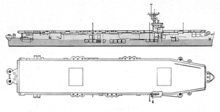Sangamon-class escort carrier
The Sangamon class were a group of four escort aircraft carriers of the United States Navy that served during World War II.
_at_anchor_1942.jpg) USS Santee (ACV-29) at anchor, 1942 | |
| Class overview | |
|---|---|
| Name: | Sangamon-class escort carrier |
| Builders: |
|
| Operators: |
|
| Preceded by: | Bogue-class escort carrier |
| Succeeded by: | Casablanca-class escort carrier |
| Built: | 1942 |
| In commission: | 1942–1947 |
| Completed: | 4 |
| Retired: | 4 |
| Scrapped: | 4 |
| General characteristics | |
| Type: | Escort carrier |
| Displacement: |
|
| Length: | 553 ft (169 m) |
| Beam: |
|
| Draft: | 32 ft (9.8 m) |
| Propulsion: | 2 steam turbines, 2 shafts, 4 boilers, 13,500 shp (10,067 kW) |
| Speed: | 18 knots (21 mph; 33 km/h) |
| Complement: | 860-1080 officers and men |
| Armament: |
|
| Aircraft carried: | 25-32 Grumman F4F Wildcat & Grumman TBF Avenger or Douglas SBD Dauntless |
Overview
These ships were originally Cimarron-class oilers, launched in 1939 for civilian use. They were acquired and commissioned by the U.S. Navy in 1940–1941. Due to the shortage of MARAD type C3 ships for conversion to desperately needed escort carriers, it was decided in early 1942 to convert four oilers to escort carriers. The conversion took around six months.[2]

These ships were the largest escort carrier conversions built for the U.S. Navy. The late-war Commencement Bay-class escort carriers were about as large, but were built as carriers from keel up. Being built as T3 tanker oilers, the machinery space was located aft, resulting in the placing of the smokestacks on both sides aft of the flight deck. They were excellent examples of the type, roomy and tough with a large flight deck and good stability on even high seas. The Sangamons could operate about 30 aircraft, and were the only escort carriers to operate dive bombers.[3]
The Sangamon class were all renamed for rivers following the contemporary U.S. Navy practice for oilers when taken into naval service and retained those names following their conversions to carriers.
Service history
From late 1942 until the end of the war the ships saw active duty in the Mediterranean, Atlantic and Pacific Campaigns. Three of the class were damaged by Japanese kamikaze attacks at the Battle of Leyte Gulf, but all survived the war. In the Pacific, the carriers often operated together as Carrier Division 22.[4]
The ships were withdrawn from active service shortly after the end of the war. Some of them were kept in reserve and reclassified as helicopter escort carriers (CVHE). All had been sold or scrapped by the early 1960s.[5]
Ships
| Ship Name | Hull No. | Builder | Laid Down | Launched | Recommissioned as escort carrier | Decommissioned | Fate |
|---|---|---|---|---|---|---|---|
| Sangamon | CVE-26 | Federal Shipbuilding and Dry Dock Company, Kearny, New Jersey | 13 March 1939 | 4 November 1939 | 25 August 1942 | 24 October 1945 | Struck 1 November 1945; Scrapped in Osaka, Japan, August 1960 |
| Suwannee | CVE-27 | 3 June 1938 | 4 March 1939 | 24 September 1942 | 8 January 1947 | Struck 1 March 1959; Sold for scrap 30 November 1959 | |
| Chenango | CVE-28 | Sun Shipbuilding and Dry Dock Company, Chester, Pennsylvania | 10 July 1938 | 1 April 1939 | 19 September 1942 | 14 August 1946 | Struck 1 March 1959; Sold for scrap 12 February 1960 |
| Santee | CVE-29 | 31 May 1938 | 4 March 1939 | 24 August 1942 | 21 October 1946 | Struck 1 March 1959; Sold for scrap 5 December 1959 |
Notes
- Friedman 1983 p. 407
- Stefan Terzibaschitsch: Flugzeugtraeger der U.S. Navy. Geleitflugzeugtraeger. Bernard & Graefe, Munich 1979, pp. 31. ISBN 978-3-7637-5212-6
- Stefan Terzibaschitsch: Flugzeugtraeger der U.S. Navy. Geleitflugzeugtraeger. Bernard & Graefe, Munich 1979, p. 67. ISBN 978-3-7637-5212-6
- Paul H. Silverstone: US Warships of World War II. Ian Allan, London 1965 (reprint 1982), p. 55. ISBN 0-7110-0157-X
- Paul H. Silverstone: US Warships since 1945. Ian Allan, London 1986, p. 23. ISBN 0-7110-1598-8
See also
- List of ships of the Second World War
- List of ship classes of the Second World War
- List of aircraft carriers
References
- Friedman, Norman (1983). U.S. Aircraft Carriers. Naval Institute Press. ISBN 0-87021-739-9.
External links
| Wikimedia Commons has media related to Sangamon class escort carrier. |